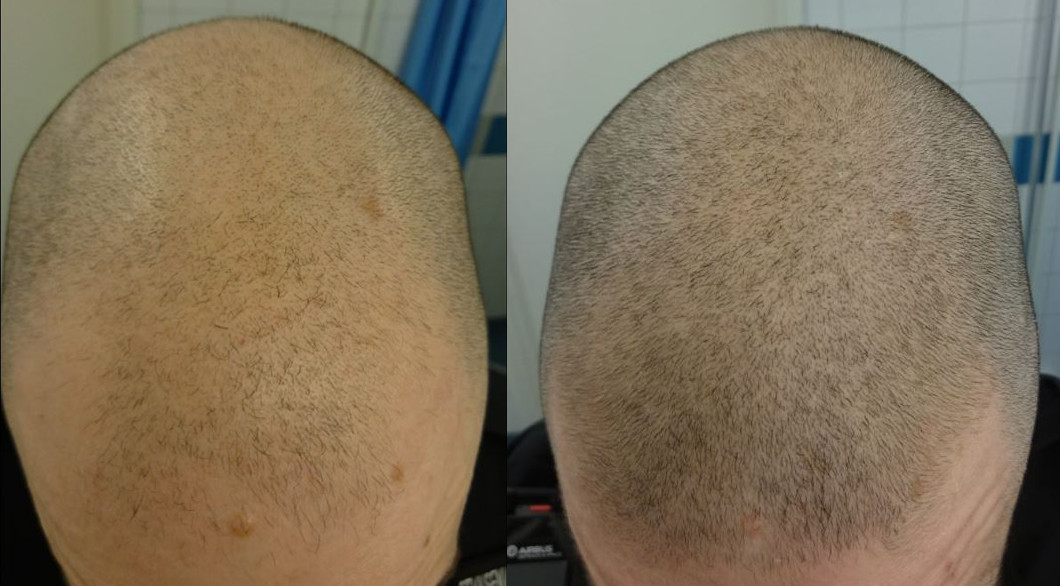- Reaction score
- 2,634
PrettyFly had pretty nice results with dermarolling + minoxidil.

Pretty nice result is an understatement....
PrettyFly had pretty nice results with dermarolling + minoxidil.

What's stopping me from then just dermarolling, applying minoxidil, and then saying I'm using follica's technology? What's novel about their approach?
The key to understanding the process is these principles:
Follica isn't simply trying to regrow hair, it is trying to create follicles de novo. So while the Indian DR study is interesting and hints that Follica *could* work, it's not apples and apples. Likewise, I think it's somewhat inappropriate for Follica to cite that study as evidence.
Idea is:
1) Create a large surface area wound by removing epidermis and disrupting the dermis. This can be done by dermabrasion, or perhaps chemical peels.
2) In normal skin, a new epidermis will be formed as the skin re-epithelializes
3) Follica wants to push chemicals into the skin that will convince the stem cells to produce hair instead of skin. Some of these chemicals may be PGE2 agonists/PGD2 antagonists, Wnt agonists, antiandrogens etc.
My hypothesis is that Cotsarelis started thinking about the PGD2 pathway as an inhibitor of the wound induced de novo regeneration process.
Old news but. sh*t... you think a hair transplant was difficult to hide.
10.1 DERMABRASION
The procedure begins with shaving/clipping of the existing hair in the area to be treated followed by a thorough cleaning with antiseptic cleansing agent. Numbing agents, such as lidocaine HCL 2% and Epinephrine 1 : 100,000, are injected to anesthetize the surface to be treated. Standard dermabrasion is performed to a depth of approximately 100 μΜ, which includes removal the entire epidermis and disruption of the papillary dermis
(detectable by a shiny, whitish appearance) inducing the formation of small pinpoints of blood in the treated area. Each dermabraded area is approximately a 1.5 cm x 1.5 cm square. Suitable dermabrasion devices are the ASEPTICO ECONO-DERMABRADER from
Tiemann and Company, the DX system from Advanced Microderm (see, e.g. ,
http://www.advancedmicroderm.com/products/tech_specs.html), or the M2-T system from Genesis Biosystems. Alternatively, sterilized sandpaper may be used for dermabrasion. Adhesive ocular shields are worn by the patient during the procedure to avoid complications due to aluminum crystals entering the eye (chemosis, photofobia, punctuate keratitis) and the doctor should wear safety goggles. The dermabrasion tool is carefully maneuvered over the area to carefully remove layers of skin until the desired level is reached. The procedure usually takes only a few minutes.
[00457] Pre-dermabrasion, patients should be asked to: not wear contact lenses during the procedure, discontinue use of over the counter exfoliation products such as Retinol, Glycolic or other hydroxy acids, Salicylic acid, Beta hydroxyl acids 3 days prior to treatment, discontinue use of retinoids 30 days prior to treatment, not receive Botox or collagen injections for 2 weeks prior to treatment.
[00458] Following the procedure the treated skin will be red, swollen and tender, and the wound should be cared for as follows until new skin starts to grow; this usually takes 7-10 days: 1) Keep the area clean and dry for today. The area should either be covered with Vaseline and bandaged after or covered with duoderm or a similar covering. Alternatively, it may be preferable to not cover, bandage, or otherwise manipulate the treated area; 2) Avoid touching the area when washing hair; 3) Pat the area dry. Do not cover, bandage, or otherwise manipulate the treated area.
You seeing results with lithium chloride?Well.... at least we'll all know what we'll look like completely shaven. That's actually on my bucket list anyway, so why not do it in order to get some hair?
Alternatively, sterilized sandpaper may be used for dermabrasion.
Pretty nice result is an understatement....
I don't have a lot of faith in one HM company's mediocre treatment turning another HM company's mediocre follicles into the real thing.
As for Follica producing stray follicles, IIRC their past experimentation produced consistently dense coverage despite the weak follicles.
I do think their science is pretty all-or-nothing. But if the company is not behaving like they have achieved "all" then it's more likely they are still at the "nothing" stage.
